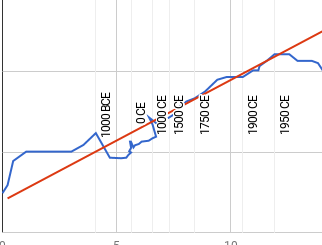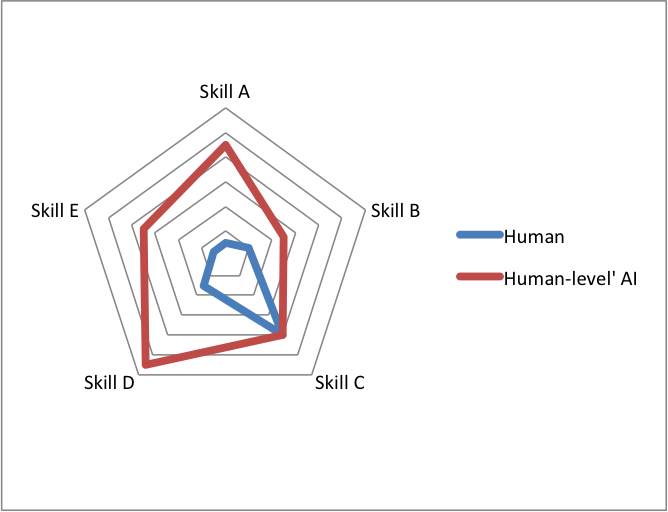Cortical neurons are estimated to spike around 0.16 times per second, based on the amount of energy consumed by the human neocortex.1 They seem unlikely to spike much more than once per second on average, based on this analysis.
Support
Energy spent on spiking
Lennie 2003 estimates the rate of neuron firing in the cortex based on estimates for energy spent on Na/K ion pumps during spikes, and the energy required by Na/K ion pumps per spike.
Lennie produces estimates for energy consumed in three parts:
- Estimates for adenosine triphosphate (ATP) molecules consumed by the neocortex: According to brain scans, glucose is metabolized at a rate of about 0.40 micro mol/g/min. Each glucose molecule yields around 30 molecules of ATP. This suggests that the entire cortex consumes 3.4 * 10²¹ molecules of ATP per minute.2 Note that ATP’s function is as energy source, so this is a measure of how much energy the neocortex uses.
- Estimates for the fraction of this ATP used to maintain ion balances: If you inactivate Na/K ion pumps with the drug ouabain, this reduces energy consumption by 50%, suggesting that these ion pumps use about half of the cortex’s energy. 3 This gives us 1.7 * 10²¹ molecules of ATP per minute being used to maintain ion balances.
- Estimates for the fraction of ion balancing ATP used in spikes: Maintaining resting potentials (not part of spiking) in all neurons costs 1.3 x 10²¹ ATP molecules per minute. This leaves 3.9 * 10²⁰ ATP per minute for spiking.4
However, other authors report higher fractions of cortical energy are spent on spiking. Laughlin 2001 writes that spiking accounts for 80% of total energy consumption in mammalian cortex.5 Other work by Laughlin and Attwell, which is a primary source for Lennie’s estimates, reports that spiking consumes around 47% of energy.6
Our understanding is that the difference can be attributed to differences between the rodent brain and the human brain, and the scaling estimates from one to the other. We are not particularly confident in this methodology.
Energy per spike
According to Lenny, each spike consumes around 2.4 * 10⁹ molecules of ATP.7 This estimate is produced by scaling up estimates for the rat brain.8 The estimates for the rat brain were inferred from ‘anatomic and physiologic data’, which we have not scrutinized.9 We are not particularly confident in this scaling methodology. These estimates appear to be produced by counting ion channels and applying detailed knowledge of the mechanics of ion channels (which consume a roughly fixed amount of ATP per transported molecule).
Spikes per neuron per second
We saw above that the cortex uses 3.9 * 10²⁰ ATP/minute for spiking, and that each spike consumes around 2.4 * 10⁹ molecules of ATP. So the cortex overall has around 2.7 * 10⁹ spikes per second. There are 1.9 *10¹⁰ neurons in the cortex, so together we can calculate that these neurons produce around 0.16 spikes per second on average.10
Even assuming that essentially all of the energy in the brain is spent on signaling, this would introduce a bias of only a factor of 8 in Lennie’s estimates. On page S1 Lennie presents an analysis of other possible sources of error, and overall it seems unlikely to us that the estimate is too low by more than an order of magnitude or so.
- The article alternates between ‘cortex’ and ‘neocortex’ in a way that suggests they refer to the same, though we are not sure that this is common usage. For instance, on page 494 the article refers to a table entitled ‘Basic statistics of the human neocortex’ to learn about the ‘cortex’.
- “Positron emission tomography (PET) and Magnetic Resonance Spectroscopy (MRS) measurements of glucose metabolism in human cortex show overall resting consumption of about 0.40 micro mol/g/min [10–12]. Assuming a yield of 30 ATP per molecule of glucose [13], this would give rise to 12 micro mol ATP/g/min. With 1 cm3 of cortex weighing 1 g [14], from Table 1, the cortical mass is 475 g, resulting in a gross consumption of 3.4 * 10²¹ molecules of ATP per minute.” – Lennie 2003 (p494)
- “The principal cost of restoring and maintaining ionic balances can be estimated from the decrease in energy consumption brought about by inactivating the Na/K pump with ouabain or an equivalent agent. Doing this reduces overall energy consumption by about 50%.”- Lennie 2003
- “the cost of maintaining resting potentials in all neurons and glia is 1.3 * 10²¹ ATP molecules per minute, leaving 3.9 * 10²⁰ per minute to support ionic movements associated with spikes,” i.e. that about 23% of energy is used for spiking.- Lennie 2003
- “For a mammalian brain… recent studies in NMR spectroscopy, which associate energy usage with neural function by following the turnover of identified metabolites and neurotransmitters, suggest that signaling accounts for 80% of the total consumption in cortex…Maintaining resting potentials and counteracting leakage from organelles accounts for less than 15% of the total consumption.”(p. 475)
- “Action potentials and postsynaptic effects of glutamate are predicted to consume much of the energy (47% and 34%, respectively).”
- “A spike consumes 2.4 109 molecules of ATP.” – Lennie 2003 (p494)
- “Neurons in human neocortex are larger than those in rat and receive and make more synapses, but they are not otherwise known to differ in their basic structure or organization. Thus, with appropriate scaling of parameters for the larger neurons, Attwell and Laughlin’s analysis can be used to estimate the energy consumed by a pyramidal neuron in human neocortex.”
- “Anatomic and physiologic data are used to analyze the energy expenditure on different components of excitatory signaling in the grey matter of rodent brain…
…Thus, the minimum Na+ influx to initiate the action potential and propagate it is 2.88 × 10⁸ Na+ (if dendrite depolarization were due to entry of Ca2 + instead of Na+ , with each Ca2 + extruded in exchange for 3 Na+ , this figure would increase by 6.8%). A realistic estimate of the Na+ entry needed is obtained by quadrupling this to take account of simultaneous activation of Na+ and K+ channels (Hodgkin, 1975), resulting in 11.5 × 10⁸ Na+ which have to be pumped out again, requir- ing 3.84 × 10⁸ ATP molecules to be hydrolyzed (Figs. 1B, 2, and 3). This 4-fold increase is validated by calculations by A. Roth and M. Hausser (as in Vetter et al., 2001), based on cell morphology and ionic current properties, which give ATP values of 3.3 × 10⁸ for a cortical pyramidal cell with a myelinated axon, and 5.4 × 10⁸ for a hippocampal pyramidal cell with an unmyelinated axon, similar to the estimate made above.” Attwell and Laughlin 2001 (pdf download)
- “From the previous section, reversing the Na+ and K+ fluxes moved by a single spike consumes 2.2 * 10⁹ ATP molecules. Given this, and 1.9 * 10¹⁰cortical neurons, the ATP available for the Na/K pump would support an average discharge rate of 0.16 spikes/s/neuron.” – Lennie 2003 (p494). That is, 3.9*10²⁰ ATP/minute/(60 seconds/ minute * 2.2* 10⁹ ATP/spike * 1.9 * 10¹⁰ neurons = 0.16 spikes/neuronsecond). Note that Lenny uses 2.2* 10⁹ ATP/spike here though he earlier said 2.4* 10⁹ ATP/spike. This inconsistency appears to be an error, but a small one).



1 Trackback / Pingback
Comments are closed.